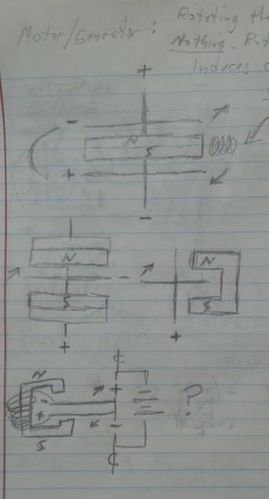So the OTC-X1 is now going into the development stage. All the physics are worked out, and we have a plan. ... mostly. All the physics aren't all worked out if we're testing the dang thing, to work out what we know currently about it, which actually is quite a good bit, in all truthfulness.
I'm sorting through YouTube videos and finding good stuff, but finding out that people don't really know why their motor works, and I hope not to be in that category.
I'm gonna show some schematics of some stuff on YouTube and elsewhere.
You gotta read this: http://www.cropcircleconnector.com/anasazi/fringe2013c.html
That link explains all about homopolar motors in DC and AC, and that they work when the disk moves, but not when the magnet moves, unless the magnet moves as the rotor itself over a wire.. combinations here, with external links. Make sure you check out the external links!!!!!!!!!!! Some are no longer active, sadly.
Here are two important external links from the main link above:
http://www.animations.physics.unsw.edu.au/jw/homopolar.htm
https://www.electronics-tutorials.ws/oscillator/oscillators.html
This link above goes into something similar to Bedini style amplification.
Homopolar motors will also act as generators.
One-piece homopolar motors just need two wires, and functions without a separate rotating disk, as seen at near the bottom of the top link in the relativity section (the whole page is EXCELLENT). The one-piece homopolar motor uses one pole of a rotating cylinder magnet (rotation around its magnetic axis), connected to a wire, and the other wire connected to the magnetic "zero plane." When the magnet is spun, the darn thing makes electricity (from just spinning a magnet and having two wires connected to it)!!

If using electromagnets, it's possible that usage of electromotive force is what kicks the electromagnet ring in the opposite direction of the utron disk rotor.
In fact in the first article, there are many weird and strange ways that rotating dynamos can work; and also ways that they cannot work.
It's recommended to do an image search on Google for "homopolar motors" and "homopolar generators."
I'm fairly certain these systems may be very compatible with the T-T L-L (Tesla-tower Ley-line).
Doing a search for "homopolar motor anti gravity" I actually see a lot of my own work in the image search, but it does seem that this is the way to go about achieving anti-gravity and warp drive. I'm thinking as well, that the resonance cavity of the hull structure has a lot to do with it. That is a common element also in the EM drive.
CHEAT SHEET: The two disks spin clockwise and counter-clockwise in the applied magnetic field from the outer electromagnet.
This will most likely be my last post for a while, probably for a number of years while this stuff gets worked out in the development stage. The T-T L-L project however is first priority for me, so be looking for that in a year or two.
By the way, the one-piece homopolar motor concept would work well with Searl technology, although I'm not sure how to charge but only the top hull, or the bottom hull, which it may only need one hull charged.
Don't forget about homopolar bearing motors, which is discussed in one part of an article below (positive and negative to bearings on opposite ends of a conductive driveshaft).
I dare say the Searl engine wouldn't work without a resonance cavity (a completed hull) around the rotating and revolving magnets, either.
Also here are two cool links: https://www.electronics-tutorials.ws/oscillator/crystal.html
... and: https://www.electronics-tutorials.ws/oscillator/wien_bridge.html
PART II
Here's a little more information in regards to aluminum repelling magnets. This is interestingly useful, and explains the mechanism behind how the outer electromagnet ring spins opposite to the rotating utron/accumulator disk.
https://physics.stackexchange.com/questions/234959/why-can-only-moving-metals-aluminium-reflects-a-magnetic-field-of-a-magnet
That isn't a very good article. No mention of Lenz's law, which is the actual law of physics that shows that a force like this opposes its own motion. But, it's a start. It explains that the spinning disk of aluminum will repell a magnet, because it reflects the magnet's poles, and at such a high spin, is considered diamagnetism.
http://www.madsci.org/posts/archives/1999-08/935437284.Ph.r.html
Also there's a lot of talk about the free electrons in a metal, which I suppose is a good explanation, because a metal is conductive to electromagnetic energy, but a rock isn't (although a rock is able to conduct electrostatic energy -- pure electrostatic without a usable magnetic wave characteristic.. call it scalar or negative energy)
Here are some videos:
| | |
 RSS Feed
RSS Feed